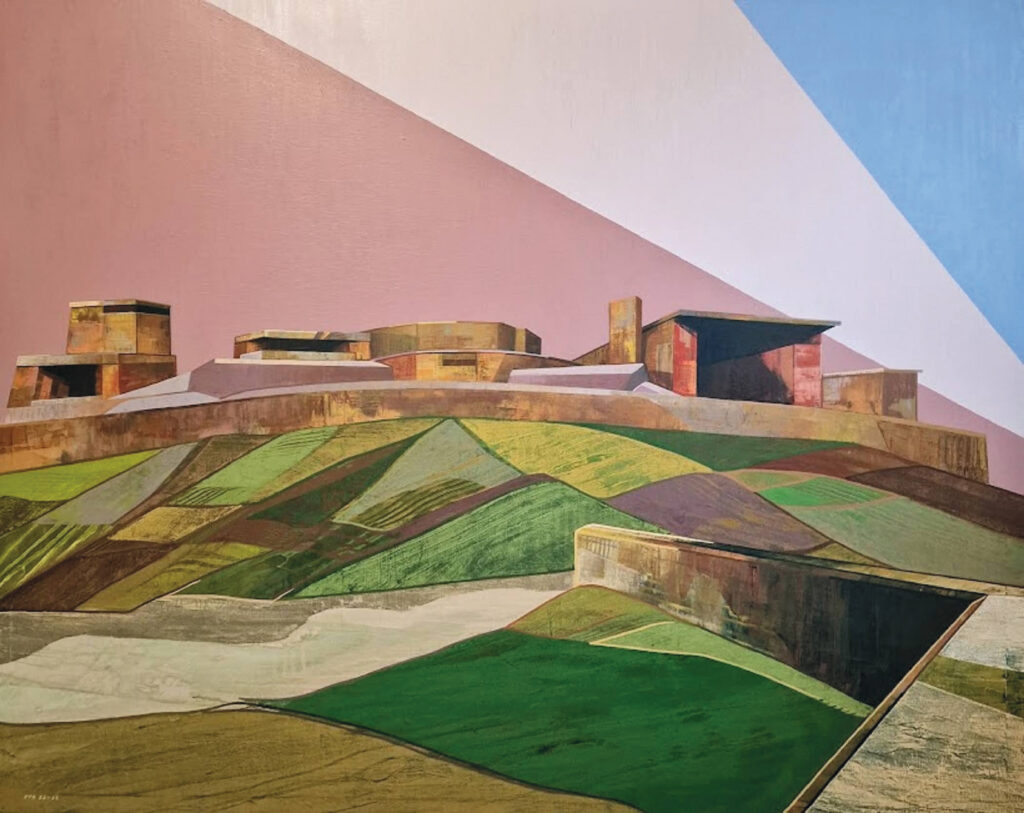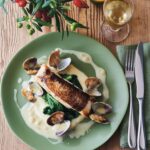Artist Ben Fenton on Painting & Mental Health
All images by Ben Fenton
Ben Fenton is a Hastings-based artist, known for his abstract paintings of local architecture and coastline landscapes. In this interview, Ben opens up about his long-term mental health struggles, his relationship with the area and the sea — and of course, his art.
Are you Hastings born and bred?
“No, I’m originally from Dungeness in Kent, so I’m a Stonerunner. My father was a trawlerman so we moved around somewhat but obviously stayed beside the coast, also living in Greatstone, Rye and Winchelsea Beach. My grandparents owned Prospect Cottage, but when my grandfather died, my nan sold it to Derek Jarman.
I moved here in 2018. I had been living in Rye but my mental health had been worsening for some time, leading to me ending up in a secure mental health hospital in 2017. When I was released, I was homeless. I moved to Hastings to try and rebuild my life.”
So how did you navigate your way out of homelessness?
“The secure mental hospital was one of the most frightening experiences of my life. I have long had dealings with the lack of effective mental health care, both in London and here in East Sussex, throughout my adult life, but it was entirely encapsulated by my stay there.
I then spent three months homeless. I did attempt to end my life, and I believe I would have succeeded without the love and support of my parents.
I believe it is absolutely imperative to be as open and honest as possible about mental illness because, without a shadow of a doubt, the stigma still remains and forces too many people to suffer silently. The only way to overcome that, and force change in the understanding that this is not something to be romanticised or feared, is by normalising its discussion. So I eventually got enough money together to rent a grotty little flat in Hastings and decided to take my art seriously.

2022 Oil on canvas H: 76cm X W: 102cm
I soon found an art community that was willing to welcome me in (Tina Morris, Ray Gange and Rowan Corkill). Life began to slowly feel like it was worth living again.
I now live in the Old Town with my son and my daughter, who has just graduated and lives in London, visits regularly. We all love it here.”
Have you received a diagnosis regarding your mental health? How is it these days?
“I suffer from manic depression and borderline personality disorder. Such fun! There’s a well-worn old cliché about artists needing to suffer for their art. I really don’t know whether that is true, but I do know that my mental illness has instilled a resilience in me that has stood me in good stead to keep making work, and the work I do make is entirely about my mental health.
My life would be very different indeed if I didn’t have this. There are often weeks and months at a time when it beats the shit out of me. When I can’t function and life seems like an endless series of resets. Because of this relationships, and even friendships, are impossible. The most insidious aspect of my mental illness is loneliness. It can be utterly crippling, so I try to express that through my painting.”
Do you think that your mental health struggles play a part in your paintings? For example, can you see your good days and your bad days in them?
“I hope that my work at first seems serene, and perhaps even beautiful, but if you were to sit with it for some time, the emptiness becomes apparent. The best way I can think to describe it is this:- The paintings I make are my attempt to express the Manic Depression and Borderline Personality Disorder I have suffered from all of my life, through the beauty of empty spaces.
The most insidious aspect of my mental illness is the loneliness I can never shake free from. By painting the unpopulated architecture and desolate coastlines I grew up with, I try to convey a feeling of isolation, manifested through a colour palette of vividness and light because it is imperative to understand that mental illness is not about darkness, but absence.”

2022 Oil on canvas H: 122cm X W: 152cm
And does painting provide you therapy in some way?
“So indeed, painting is my job and my living. In fact, it’s my vocation. But much more than that, it is my daily therapy without a doubt. I spend most of my life in a room on my own making art and there I am happy. I am very fortunate in that respect.
However, I would swap it all in an instant to be able to hold together a loving relationship and family life.”
“I hope that my work at first seems serene, and perhaps even beautiful, but if you were to sit with it for some time, the emptiness becomes apparent.”
Are you self-taught or did you attend art school?
“I am a self taught artist. I moved to London at 18 as an apprentice hairdresser and quit that to become a gym instructor in Soho. I bought myself a couple of canvas boards and some oils and began to paint, with the ambition of one day making something I would be happy to hang on my wall.”
What does your creative process look like? “My paintings always begin as photographs that I take myself. I have thousands stored away that I may sit on for years before I think they’re ready to try and work on. I plot them in and then begin a process I have developed slowly over the last five or six years. It’s very laborious and involves the application of oil paint and spraying of white spirit whilst the canvas is manipulated to achieve texture and direction. That is repeated, often for weeks, until it feels right, then paint is scraped on, and off, again and again before lining in is attempted. There really is no definitive timescale to the paintings I make. If everything flows well, they could take three to four weeks, but some are worked on for months, and others years.”
What is it about Brutalist architecture that appeals to you?
“My fascination with painting concrete begins back on my native Romney Marsh. The sea defenses have always been imperative to the Marsh due to it being so far below sea level.
The unofficial motto of the land is borrowed from the Dr Synn novels which were set in Dymchurch:- ‘Serve God, honour the king but first maintain the wall!’
The modern sea walls found at Broomhill Sands and Dymchurch are concrete rebuttals to the English Channel reclaiming the lands we have borrowed from it. Again, I find a beautiful simile between that and mental illness, but on an aesthetic level, concrete is fascinating. I began attempting to paint it through the sea walls and Bottle Alley and realised it’s impossible to capture, due to its surface morphing and reflecting the environment and weather surrounding it. Those early attempts led to further exploration and something of a eureka moment. I had always felt an affinity to Brutalism due to its uncompromising nature, but pairing the scale and vague foreboding of Brutalist architecture with the almost intangible nature of its veneer gives me an itch I need to scratch.”

And what is it about Bottle Alley that you love to paint so much?
“When I moved to Hastings I was very quickly recommended Bottle Alley as a possible place to paint. I instantly fell in love with it, and the other architectural gems scattered around the town by Sidney Little.
But there is something about Bottle Alley’s strength, solidity and faded grandeur, set against the shifting shingle and endless cold grey green waters that inspire me. Along with the Dymchurch Grand Redoubt, it has best come to represent my mental illness in my works.”
Where are you exhibiting at the moment? “I am represented by Taylor-Jones & Son Gallery in Deal, Kent so the art I make is exhibited there.”
What locations do you have in the pipeline for painting?
“Next year I am planning on photographing and painting the Maunsell Forts off of the north Kent coast. I shall also be exploring more of the British Isles and painting the coastlines and architecture that I feel is appropriate.”
Your grandparents owned Prospect Cottage before they sold it to Derek Jarman. What was it like spending parts of your childhood there?
“I am a Dungenesser. It was a very different place in the late seventies and eighties. I spent the first week of my life there as my dad was away at sea.
When we moved away, my sister Melanie and I would often spend weekends and school holidays visiting my grandparents. It was obviously normal to us, but with hindsight it was incredibly free and exciting, as well as wild and woolly. We would roam the beach and the gravel pits and my papa would have daily bonfires out the back. My grandparents were incredibly loving and each night we would camp down in my nanna’s bedroom and she would tell us stories as the rain battered down and the intermittent beam from the lighthouse illuminated the room through her thin pink curtains to the accompanying mournful call from the foghorn. It was blissful!”
Did you have a happy childhood? I read that your father would take you out fishing at the age of four...
“My father first took me out to sea when I was four years old. He fished out of Rye then, and because it is a mile and a half from the sea, once you had committed to steaming out, you had to stay out for at least twelve hours.

That first night was particularly stormy and we didn’t have life jackets so he tied me to the mast! I thought it was the greatest thing in the world. Dad was an experienced fisherman and I never once felt in any danger, despite it being a job fraught with so many things that could go drastically wrong. I’ve seen water spouts, submarines breach through the water and masses of jellyfish as far as the eye could see. It was again, something I took for granted when I was young, and despite it being incredibly hard work, a privilege that not many people get to experience. I have nothing but respect for anyone who works on the sea.”
Would you say that you’re ambitious as an artist? What are your dreams for the future?
“Ambition as an artist is something I struggle with, and ambition as a man that has this mental illness often seems like a luxury I cannot afford, or am not allowed. However, I do have things I want to achieve. I hope I can continue to make the work that I do. I am of the opinion that every day in my studio is a little victory. I believe my work is constantly improving, and that excites me. I hope that I can demonstrate that mental illness is possible to live with. Most importantly, I hope I can be a good father and find a point where I can find real happiness.” ⚫



